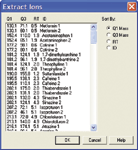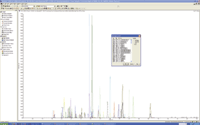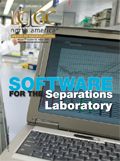Maximize Mass Spectrometry Through Software
Special Issues
Increases in the speed and sensitivity of MS systems have set new standards in quantitative and qualitative analysis.
New developments in software applications have redefined laboratory workflows in a number of areas, including metabolite identification, biomarker research, metabolic profiling, forensic toxicology, and lipidomics research, to name just a few. Faster data acquisition and processing, more advanced automated features, improved auditing and security capabilities, and greater control from a single console have optimized the use of mass spectrometry (MS) through software. This article describes how software is a critical link for advancing life science in regulated and nonregulated environments across both standalone and networked laboratories.

Metabolite Identification
The importance of metabolism studies to the drug discovery process is undisputed. For example, the benefits to pharmaceutical companies to identify potentially toxic metabolites in a drug candidate as early as possible are significant. Metabolite identification studies have been given increased emphasis in light of the recently issued Metabolites In Safety Testing (MIST) guidelines. Despite the importance of absorption, distribution, metabolism, and excretion (ADME) studies, the process of conducting them can be extremely time-consuming and inefficient. Improvements in instrumentation and software to automate parts of the process hold the potential for considerable benefits to drug metabolism researchers. Significant efficiency gains have been made in metabolism data collection through improved liquid chromatography (LC) instrumentation and in data processing through improved software for data analysis and metabolite identification (Figure 1).

Figure 1: The processing workspace displays all the data associated with a metabolite in one view.
Software streamlines the process from acquisition through to confirmation to more quickly and easily mine the data to find metabolites, making the work of identifying metabolites more efficient than ever. Scientists are seeking a single integrated workspace, clearly displaying all the data associated with a potential metabolite and eliminating the need for tedious visual comparison of printouts. Intuitive and well-defined processing parameters are needed to allow rapid sample-to-control comparisons.
Overlaid extracted ion chromatograms of the sample and control allow easy visual comparison of chromatographic peaks. Adjacent and aligned displays of the parent and metabolite MS-MS spectra make spectral similarities and differences immediately obvious. Moreover, software automation is needed in three distinct areas: automatic generation of dedicated MS-MS methods based upon a potential metabolite identified, automatic comparison of the MS-MS spectra of a potential metabolite to that of the parent compound, and automatic report generation. By doing this, the process of metabolite identification is made more efficient compared to traditional manual sample and control comparisons.
The trend is to create and start using complex multiperiod, multiexperiment methods with a few mouse clicks. Data for all metabolites are acquired in as few injections as possible, preferably no more than one. The software should show the list of potential metabolites from the survey scan that require MS-MS data for confirmation. In this case, the "wizard" incorporated these into a period-based, dedicated MS-MS acquisition. Overall, with this approach, a significant improvement in throughput for the data-analysis process and acquisition of confirmatory MS-MS for metabolism studied is accomplished. In particular, this unlocks the power of a hybrid linear ion trap LC–MS-MS system, which combines selective survey scans to detect low-level metabolites and qualitative ion trap MS-MS spectra for structural elucidation on a single platform.
Scientists also are seeking ways to create highly optimized methods in a fraction of the time previously required. This is an ideal opportunity for software advancements to meet this demand with automated method-creation tools to build a variety of methods, such as multiple reaction monitoring with information-dependent acquisition (MRM-IDA), or precursor ion scan with or without IDA, among others. Each type of survey scan has its inherent utility for metabolite identification: full-scan MS for high-concentration, clean-matrix analysis, precursor and neutral-loss scans for low-level metabolite identification and MRM-IDA for trace-level or in vivo experiments. There are even specific automated method-building capabilities to find conjugates and active metabolites, such as glucuronides and glutathiones. The intelligence of the software makes the difference.
Scheduled MRM
Part of maximizing the utility of mass spectrometry is maximizing sensitivity, precision, and accuracy of quantitative results with scheduled MRM. The algorithm for scheduled MRM monitors MRM transitions only when the parent ion elutes from the column, and not continuously throughout the chromatographic run. The algorithm provides the ability to arrange multiple overlapping time periods for data acquisition according to when a compound is eluted, allowing maximum dwell time per MRM for optimal quantitative data quality.
The user of the mass spectrometer simply needs to enter in the expected retention time and MRM transition for each compound along with a general target scan time and MRM detection window for the run. The software algorithm then automatically builds an acquisition method that schedules the appropriate MRM transitions over the chromatographic analysis during the appropriate time window.
Instead of monitoring all 300 transitions throughout the entire run, for instance, the MS system will monitor only those transitions within the targeted time window. Doing so reduces the number of compounds being monitored at a given time, improves the duty cycle, and provides better quantitative accuracy.
With proper software, scientists can assign compound names to MRM transitions in the acquisition and quantitation method to more easily link specific compounds to their results for easy data analysis. It is beneficial for scientists to be able to view all MRM transitions acquired in a data file or time window with one click on the header text of the total ion chromatogram. The user can sort data by retention time, compound name, or Q1 or Q3 mass to interrogate results for a specific compound (Figure 2).

Figure 2.
Regulatory Compliance
Using the right software for GLP compliance in a regulated environment is critical. Pharmaceutical scientists, in particular, look for software that provides comprehensive security and centralized audit trail features to underscore confidence in valid electronic records — all while being easy to use.
Software also provided centralized management for building and operating a 21 CFR Part 11-compliant environment. Laboratory managers want to know that they have adopted the best security model available for regulated laboratories. If they do not have it, they want to shift to it and be able to incorporate it without disrupting operations. The ideal approach is to integrate into existing workflows by directly connecting to the laboratory's LIMS and processing tools through a complete library of software components and support.
Clinical Research
Clinical research laboratories throughout the world are discovering the analytical power of LC–MS-MS and its ability to identify accurately and quantify minute amounts of compounds in complex sample matrices such as blood, urine, and oral fluid. Software is helping to expand the use of MS systems for a variety of research that can be performed with a single instrument system.
LC–MS-MS is powerful for clinical toxicology and forensic drug screening. With the increasing number of toxic compounds in our daily life and with thousands of fatal drug intoxications reported annually, there is a need for rapid screening methods to identify the cause of the intoxication quickly. Traditional methods typically are limited to substance classes; lack specificity, leading to false positives; and sample preparation often can be time consuming.
Researchers are investigating the ability of LC–MS-MS methods to identify compounds rapidly over a wide molecular weight and polarity range in a single analysis and often without the need for extensive sample preparation, such as derivatization and complex liquid-liquid or solid-phase extractions. A system such as the QTRAP LC–MS-MS system (Applied Biosystems, Foster City, California) provides the additional capability to generate a unique MS-MS spectrum that serves as a fingerprint for each drug detected. This spectrum can be searched against a library for compound identification. Software contributes to this work by simplifying and automating the workflow, from sample submission to data processing to final reporting of results.
Studying Lipids
Scientists require versatility, sensitivity, specificity, and speed for high-throughput lipidome profiling of complex biological extracts by either direct infusion electrospray or LC–MS methods. For optimal results, data-acquisition strategies should be coupled with automated data processes for lipid species identification and quantitation, which is where software can help.
New software advancements are enabling the identification and characterization of lipid species by automatically searching MS-MS data against a database of characteristic lipid fragments and neutral losses. A report containing graphical and numerical information on the various lipid molecular speices, lipid classes, fatty acids, and long-chain bases present in the sample is generated. The goal is to streamline various steps, such as automated data processing, method selection, lipid species identification, comprehensive isotope contribution removal, multiple internal standards-based quantification, visualization, and reporting of results.
Experimental Section
Following are examples of different software applications in action:
Metabolite identification: A set of verapamil in vitro hepatocyte metabolites were spiked into bile matrix at a low level (2.5 μM) to mimic the in vivo sample matrix. LightSight 2.1 software (Applied Biosystems) provides an easy yet comprehensive set up of pMRM experiments, a new novel survey mode. This new type of IDA experiment can be created automatically using the software and loaded directly to the mass spectrometer for rapid analysis. The advantages of pMRM methods are the improved detection limits, the higher signal-to-noise ratios, and the greater selectivity that results in more efficient data reduction and analysis compared to single MS and mass defect filter (MDF). In this example, the pMRM survey mode was employed as the survey scan of an IDA experiment. Even with the high level of bile salts in the sample, the pMRM survey scan allowed for selective and accurate peak determination. Often, in single MS mode, bile salt background can be so overwhelming that low-level metabolite detection is nearly impossible.
A total of 30 metabolites were detected using a single-injection pMRM method with five more detected by the addition of a dual Prec/NL survey scan IDA method. pMRM found the most metabolites in a single injection based upon the high level of sensitivity in this mode. No major metabolites were missed by pMRM and IDA efficiency was very high, making it an excellent single injection strategy. The ability of pMRM to predict a comprehensive list of transitions allowed for the detection of a number of interesting metabolites (bis-dealkylation with and without glucuronidation, tri-demethylation and oxidation and glucuronidation at different parts of the molecule). The Prec/NL dual survey scan also was very effective, detecting many of the same metabolites as well as five new species. The dual survey mode is a good complement because some truly radical metabolites might be best detected by a pair of precursor ion and neutral loss scans, because no predictive heuristic logic is needed prior to the experiment. If definitive metabolite profiling is required, a two-injection method can prove useful. Both the method generation–optimization and the subsequent data analysis and mining are enabled by the software.
Clinical research: The simultaneous analysis of amino acids and acylcarnitines panels provides information on about 40 metabolic disorders, such as phenylketonuria (PKU) and medium chain acyl-CoA dehydrogenase deficiency (MCAD). A simple flow-injection analysis gives results in 2 min with minimal sample preparation. In recent years, researchers have extended the use of LC–MS-MS to include the very long chain fatty acids for characterizing the peroxisomal disorders and other clinically relevant markers such as the panel 17-OH progesterone–androstenedione–cortisol for characterizing congenial adrenal hyperplasia (CAH).
ChemoView software (Applied Biosystems) has been designed for researchers who want to quickly screen for a series of compounds from a large data set to uncover compound specific information associated with such issues as inborn errors of metabolism, specific metabolic or lipid studies or compound specific profiling from a range of different workflows. This software enables such analysis by providing a range of data-analysis tools to mine the data generated to identify specific compounds within large sample sets, implement custom calculations across results, and flag results according to predetermined upper and lower limits.
Cliquid software (Applied Biosystems) can be used with an available drug screening iMethod Test and 1250 compound drug library to screen for hundreds of drugs in a single analysis in minutes with minimal sample preparation. With the ability to screen for both known or unknown compounds and provide confirmation and quantification, This software, when used in conjunction with LC–MS-MS, can screen for, quantify, and confirm hundreds of drugs of abuse from blood, urine, hair, tissue, and other biological matrixes.
Applied Markets: While LC–MS-MS is seen as a powerful analytical technique, many laboratories are reluctant to adopt such technology due to the perceived level of complexity in running such equipment. Many of the features described in this article can help reduce the complexity.
Mark M. Garner and Tania Sasaki
Applied Biosystems, part of Life Technologies
Please direct correspondence to product.info@lifetech.com

Thermodynamic Insights into Organic Solvent Extraction for Chemical Analysis of Medical Devices
April 16th 2025A new study, published by a researcher from Chemical Characterization Solutions in Minnesota, explored a new approach for sample preparation for the chemical characterization of medical devices.
Sorbonne Researchers Develop Miniaturized GC Detector for VOC Analysis
April 16th 2025A team of scientists from the Paris university developed and optimized MAVERIC, a miniaturized and autonomous gas chromatography (GC) system coupled to a nano-gravimetric detector (NGD) based on a NEMS (nano-electromechanical-system) resonator.
Miniaturized GC–MS Method for BVOC Analysis of Spanish Trees
April 16th 2025University of Valladolid scientists used a miniaturized method for analyzing biogenic volatile organic compounds (BVOCs) emitted by tree species, using headspace solid-phase microextraction coupled with gas chromatography and quadrupole time-of-flight mass spectrometry (HS-SPME-GC–QTOF-MS) has been developed.
A Guide to (U)HPLC Column Selection for Protein Analysis
April 16th 2025Analytical scientists are faced with the task of finding the right column from an almost unmanageable range of products. This paper focuses on columns that enable protein analysis under native conditions through size exclusion, hydrophobic interaction, and ion exchange chromatography. It will highlight the different column characteristics—pore size, particle size, base matrices, column dimensions, ligands—and which questions will help decide which columns to use.













